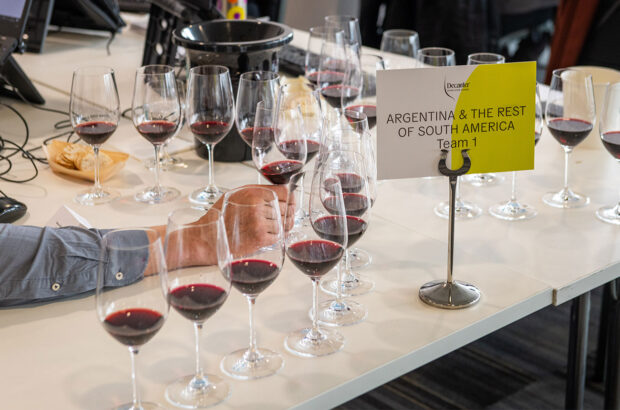Andrew Jefford hails the insights of a new climate study for future UK plantings...
A flourishing English sparkling wine scene is one of the few pieces of climate-change good news, and the magnificent 2018 English wine harvest has brought it into close focus. The timing, therefore, could hardly have been better for the publication of an academic paper last month outlining what we might call the terroir potential of England and Wales. Lead author is Dr Alistair Nesbitt from the English Vine and Wine Consultancy, working with Professor Stephen Dorling and Professor Andrew Lovett of the University of East Anglia.
This outstanding piece of work, drily called A suitability model for viticulture in England and Wales: opportunities for investment, sector growth and increased climatic resilience, is free to view and to download here. I strongly recommend it, not only because of its insights into the potential for sparkling wine production in England and Wales, but also because its synthesis of a number of complex data sets suggests that we may, now, be getting closer to defining and to understanding terroir in a scientific sense. This would be a significant and exciting breakthrough for a field long bedevilled by unsubstantiated generalities, vague assertions, pseudo-science and wishful thinking.
The study is also fascinating for its use of fuzzy logic (which allows for the existence of partial truths, uncertainly and imprecision) rather than Boolean logic (by which everything is either true or false) in defining the data sets. This, too, seems to me to be eminently sensible for terroir, with its tapestry-like complexities and often confounding unpredictability. The authors intend their study to be of use to potential vineyard investors (real people, real money), and suggest that a rigid true/false approach to data analysis can engender both unjustifiably risky and over-cautious assessments.
Before describing the sometimes surprising conclusions of the study, let me just run through some of the assumptions made by the authors about aspects of site and climate in the UK.
The ideal elevation for English and Welsh vineyards is assumed to be less than 100 metres, with a notional optimum of 52.5m, which seems fair for such high-latitude sites. (In Argentina’s low latitudes, by contrast, the situation is radically different; indeed altitudes are even a little higher than this in Champagne.) South-facing slopes of between 5 to 10% are considered optimal; any steeper and you can’t use machinery; any flatter and you risk frost. The soil parameters are sensibly broad. Drainage isn’t addressed per se, though it’s vitally important; most fundamentally suitable sites, however, can have their drainage improved, as has always happened in key French vineyards.
Climate data is critical, and the authors are sceptical about the use of bioclimatic indices such as growing degree days on their own, calling them ‘crude measures of suitability that may mask or overstate true viticulture potential in a specific location’. Their model uses a growing season average temperature index and hourly sunlight data together with growing season total precipitation and inter-annual variability, June precipitation on its own (this being the flowering month in English and Welsh vineyards) and days of air frost in April and May, frost being the surest crop-killer of all. All this data is overlain, ‘fuzzified’ and crunched, though you’d need to be a trained analyst to understand the technical nuances of the authors’ approach.
There is no wind data set at present, though this is a refinement the authors are considering for the future. Whenever I have spoken to experienced Champenois about vine-growing conditions in England, they often mention wind as being an extra element of difficulty here, and this is certainly a factor in the chronically low yields experienced by many UK vineyard owners. The UK average was 19.3 hl/ha in 2016 and just 5.98 hl/ha in 2012; the best year between 2000-2016 was 2014, with a UK average of 31.5 hl/ha — compared to an overall average of 65-75 hl/ha in Champagne.
When I asked Dr Nesbitt about this, he pointed out that it was difficult to obtain data on wind at 2m (vine height) – and he also stressed that the optimum altitude their model envisages is lower than plantings in Champagne, hence less exposed to prevailing winds. This aspect of site, too, can be ameliorated with windbreaks, already widely used by successful English vineyards.
What, then, of the results? In terms of raw data on terrestrial suitability alone, regardless of climate, Devon emerges as the most suitable county; once that data was fuzzified, though, the counties along England’s southeastern coast (Norfolk, Suffolk and Essex) seem more suitable.
Add the climate data, and the picture becomes more nuanced still. In terms of temperature and overall rainfall, Essex, Cambridgeshire, Suffolk and the Isle of Wight look most interesting, with the Isle of Wight also having attractively low June rainfall. Frost risk drops away in coastal locations (and in London), but Norfolk, Suffolk and Cambridgeshire have a marginally lower risk than South-East and Southern England, as do Dorset and Cornwall. Sunshine hours and low levels of inter-annual variability are optimal in coastal zones.
Crunch the whole lot, and what do you get? The answer is a “comprehensive viticulture suitability model for England and Wales” at an intricate scale (50 x 50 m cells).
Top location would be the Isle of Wight – though the island is a statistical outlier in terms of overall size — followed by Suffolk, West Sussex and Essex. Slicing off the top 20 per cent of this suitable land gives you a Champagne-sized zone (33,700 ha) of prime land, with the largest share in Kent, West and East Sussex, Essex and Suffolk. Slice down once again to the top five per cent of that zone, and West Sussex is best placed (911 ha), followed by East Sussex (503 ha), Kent (468 ha), Suffolk (348 ha) and Cornwall (341 ha).
How does all of this relate to existing vineyard plantings? We are, at present, comprehensively adrift of the 33,700 ha identified by the authors: UK plantings have only just crossed the 2,500 ha threshold, with most concentrated in Kent (320 ha), West Sussex (310 ha) and East Sussex (253 ha).
The authors analysed the UK’s 13 largest existing vineyards in detail, and suggest that, when both climatic and terrestrial suitability is taken into account, there may be more than a quarter of a million ha of potential vineyard land ‘with a greater suitability value rating than the highest of the existing 13 largest vineyards in England and Wales’: an astonishing possibility. It was ambition and intuition rather than scientific study, of course, which often led to the planting of existing vineyards.
The most striking finding of all concerns the potential of England’s eastern coastal counties. ‘As well as opportunities for expansion within the currently dominant regions of Kent and Sussex,’ the authors suggest, ‘new areas such as Essex and Suffolk in particular, where relatively few vineyards currently exist, have been shown to have highly suitable land, express high degrees of climatic suitability and greater levels of stability from season to season than areas currently populated with vineyards. The lack of viticulture practiced [here] is therefore somewhat surprising and may result from successful cropping in other forms of agriculture or horticulture. However, it could also be partly explained through a prior lack of nationwide suitability analysis and investment momentum regarding establishment of vineyards in the south-east.’
Perhaps – though this is my interpolation — sociological factors are at play here. The ‘posh’ southern counties were where the wine-loving retired military officers, moneyed landowning aristocrats, former stockbrokers and ambitious hedge-fund managers lived or live: the folk who have driven much of English wine creation thus far. This population segment has been thinner on the ground in unpretentious Essex and rural Suffolk – but the truths of terroir will out. If you’re thinking to plant, look east.







